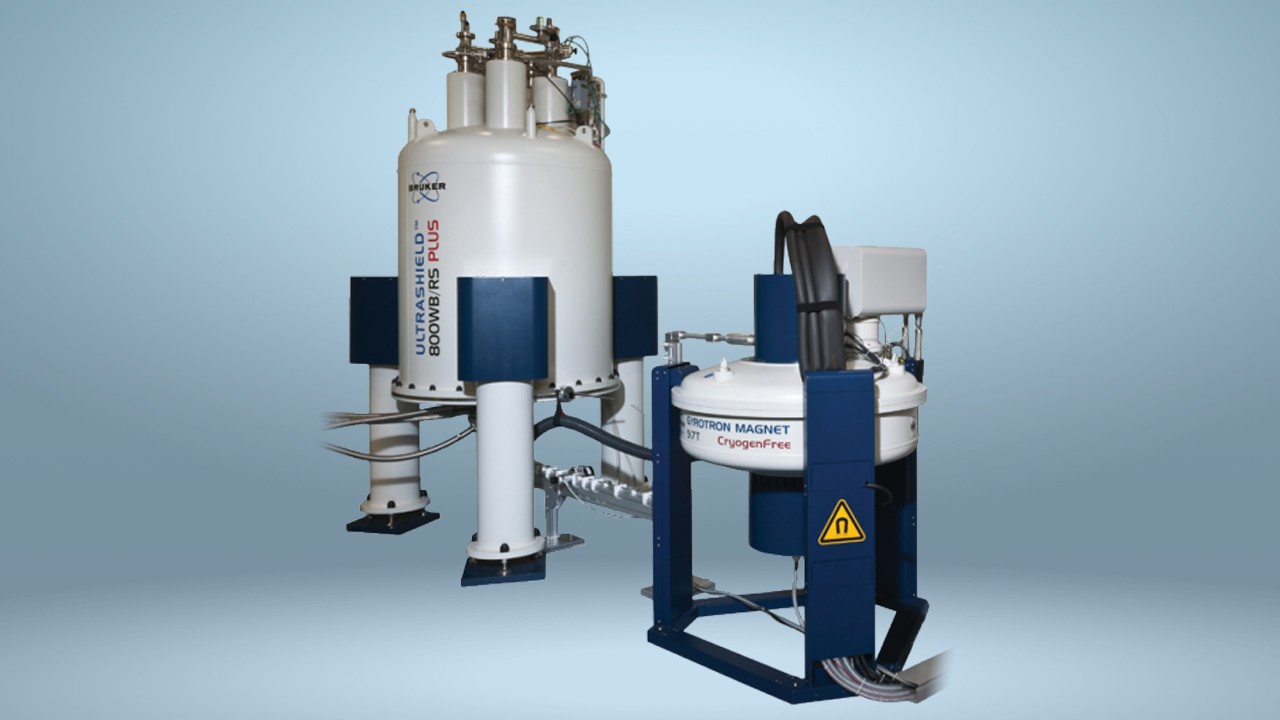

DNP-NMR of Nanostructured Materials and Heterogeneous Catalysts
Nanostructured materials, including micro- or meso-porous solids as well as nanoparticles, have applications in many fields, such as catalysis, energy and drug delivery. The global market for nanomaterials has been estimated in 2012 by the European Commission at 11 million tonnes at a market value of EUR 20 billion. In particular, the majority of heterogeneous catalysts, which are used in some 90% of all chemical processes worldwide, contains nanostructured materials.
Understanding the atomic-scale structure of these nanostructured materials is essential to establish their structure-properties relationships and hence for the rational development of new materials for applications as diverse as the capture of CO2, energy storage, hydrogen production or medical imaging.
Because it is non-destructive and provides information on the local atomic scale, solid-state NMR spectroscopy is a powerful analytical method for structural characterization of nanostructured materials.
Nevertheless, the small magnetic moments of the nuclear spins result in intrinsically low NMR sensitivity, which poses major limits for the NMR observation of interfaces, surfaces, defects and insensitive isotopes with low gyromagnetic ratio and/or low natural abundance (13C, 29Si, 17O…).
At UCCS institute (Univ. Lille-CNRS), professor Olivier Lafon and his colleagues are among those who have demonstrated in recent years how Dynamic Nuclear Polarization (DNP) can boost the sensitivity of NMR experiments on nanostructured materials and hence bring new opportunities for their characterization.
The DNP method consists in transferring the large polarization of unpaired electrons to the surrounding nuclei by microwave irradiation near the EPR frequency. This approach can reduce acquisition times by 4 to 5 orders of magnitude. Concurrently, DNP experiments can be carried out in conjunction with Magic-Angle Spinning (MAS) at high magnetic field (up to 18.8 T), which allows the acquisition of high-resolution NMR spectra. The enhanced polarization can be exploited synergistically with advanced multidimensional NMR experiments.
The UCCS team has applied DNP for the characterization of a wide range of nanostructured materials, including mesoporous silica1, mesoporous alumina, metal-organic frameworks2 and diverse nanoparticles.3,4
The researchers of UCCS in collaboration with the group of Geoffrey Bodenhausen have notably used this approach to gain new insights into the catalytic activity of nitridated fibrous silica (KCC-1) nanocatalysts. This finding has been published in Angew. Chem. Int. Ed.4 These nitridated KCC-1 nanoparticles have shown excellent activity for CO2 capture and solid base catalysis.
Higher nitridation temperatures increase the nitrogen content of these silicon oxynitrides, but, paradoxically, decrease their catalytic activity. This property was not explained so far, despite exhaustive characterization by N2 sorption, TEM, SEM, XPS, FT-IR… Similarly, previous studies by conventional NMR techniques did not allow the identification of the silylamine sites in nitridated mesoporous silica.
The sensitivity gain provided by DNP has enabled Lafon and co-workers to observe for the first time 15N sites at the surface of nitridated KCC-1 nanoparticles, in spite of the low natural abundance (0.37%) and gyromagnetic ratio of this isotope.
These 15N DNP-NMR experiments have permitted to explain for the first time the decrease of the catalytic activity of nitridated KCC-1 when increasing the nitrogen content. This phenomenon is due to the conversion of primary silylamine sites into secondary ones at nitridation temperature greater than or equal to 800°C.
Besides structural characterization, DNP-NMR of nanostructured materials also turns out to be a fruitful approach to understand DNP phenomena. The UCCS researchers have shown that DNP direct excitation enhances the signal of nuclei near unpaired electrons, whereas in DNP-enhanced cross polarization from protons, 1H spin diffusion distributes the polarization within the sample.1,3
Lafon and his collaborators have also reported polarization leakage in nanostructured materials containing endogenous paramagnetic centers, which do not contribute to the DNP transfer.3 These paramagnetic defects drive the polarization of surrounding nuclei back to thermal equilibrium and hence reduce the efficiency of the DNP transfer.
Advances in DNP instrumentation (high field, low temperature probes, coherent microwave pulses…), polarizing agents and sample preparation is expected to open in the near future new frontiers in NMR sensitivity and thus new avenues for the characterization of nanostructured materials.
References:
(1) Lafon, O.; Rosay, M.; Aussenac, F.; Lu, X.; Trébosc, J.; Cristini, O.; Kinowski, C.; Touati, N.; Vezin, H.; Amoureux, J.-P. Angew. Chem. Int. Ed. 2011, 50 (36), 8367–8370.
(2) Pourpoint, F.; Thankamony, A. S. L.; Volkringer, C.; Loiseau, T.; Trébosc, J.; Aussenac, F.; Carnevale, D.; Bodenhausen, G.; Vezin, H.; Lafon, O.; Amoureux, J.-P. Chem Commun 2014, 50 (8), 933–935.
(3) Lafon, O.; Thankamony, A. S. L.; Rosay, M.; Aussenac, F.; Lu, X.; Trébosc, J.; Bout-Roumazeilles, V.; Vezin, H.; Amoureux, J.-P. Chem. Commun. 2013, 49 (28), 2864–2866.
(4) Lilly Thankamony, A. S.; Lion, C.; Pourpoint, F.; Singh, B.; Perez Linde, A. J.; Carnevale, D.; Bodenhausen, G.; Vezin, H.; Lafon, O.; Polshettiwar, V. Angew. Chem. 2015, 127 (7), 2218–2221.


